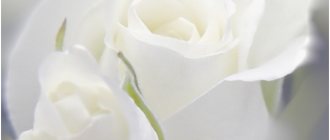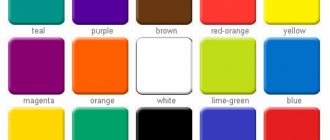Nastya Roshchinskaya, content marketer at SendPulse, wrote an article specifically for the Netology blog about how to evoke different emotions in email newsletter subscribers using color.
Colors are believed to influence human emotions and behavior. What does the right color do in email marketing? Helps lead the consumer to the target action and increase brand awareness. In this article I will tell you what associations different colors evoke and how well-known companies use this in their mailings.
Training program: “Email marketing: increasing sales and expanding our customer base”
What the Research Says
The perception of color depends on personal preferences, upbringing and cultural characteristics of a person, but when it comes to shopping and interaction with a brand, there are also universal points:
- for 80% of users, color affects brand recognition;
- 90% of customers decide to buy based only on the color of the product.
Color helps a brand stand out and be remembered from its competitors. It awakens memories and affects a person’s emotional state. And each in his own way. Let's figure out what email marketers can do about it.
What kind of mood is there?
With all the variety of types of mood, a person usually characterizes it as good or bad.
A bad mood is...
The symptoms of low mood are known to everyone:
- everything seems hateful;
- laziness overcomes;
- there is no desire to communicate with family and friends.
Depending on mental characteristics, a person tries to either hide from the world or take it out on loved ones. We do not always understand the reasons for our condition, it is important to know one thing - a bad mood is an indicator that not everything is going well in our lives.
It is necessary to understand the causes of decreased tone, especially if the condition recurs regularly. After all, a bad mood that persists for a long time is already depression that needs to be treated. Constant despondency provokes other bodily ailments, including oncology.
Most often, this tone causes dissatisfaction with oneself, a feeling of guilt, and a lack of purpose. Calmly analyze what could have caused the decline in emotional background. A bad mood is a reason to delve into yourself. Why have I stopped loving myself so much that I allow sadness to ruin my life?
Eradicate dislike for yourself, pamper yourself like a little child. Sometimes a bad mood is a reaction to pathological processes in the body, changes in hormonal levels. In this case, you should consult a doctor for an examination.
good
A person in a cheerful mood can be identified even visually. He has a straight back and a mischievous look. Physiological processes are activated - the stress hormone cortisol is absent, heart function improves, facial muscles are relaxed, and an involuntary smile appears. Optimists and cheerful people look very young for quite a long time, their nasolabial folds are less pronounced.

In a good mood, we are ready to “move mountains”; any activity is productive and interesting. We enjoy doing household chores, finding pleasure in cleaning the apartment and plowing the potato field. At work, at such moments, we are able to redo everything that we have been putting off for a long time.
A person can hum, reaches out to people, they are close to him, and the level of empathy increases. There is a tendency to help people “just like that”, without demanding anything in return. Even old enemies don’t seem so unpleasant, and you don’t even want to think about them at all.
Creativity in this state also increases - new ideas appear, you want to engage in creativity or sports. A person thinks through plans to improve himself and his life - take up physical training, find a new source of income. I want to rearrange the furniture in my apartment and buy a new tablecloth.
A good mood is an emotional uplift, which has a great effect on health, appearance and leads to productive activity.
Yellow - we revive and lure
The sun and happiness are the first associations that come to mind. Rich yellow expresses joy, optimism and spiritual lightness, while darker shades are both calming and invigorating.
Yellow encourages impulsive shoppers, so use it in your flash sale or clearance emails. Add yellow if you want to cheer up your subscribers.
The Alice and Olivia newsletter is bright yellow, but it doesn't cause alarm or fear. On the contrary, the connection between the online store’s promotion and the legendary The Beatles and their hit Yellow Submarine comes to the surface:

Types of moods
Bad and good mood are states that we understand, but this classification is very simplified. In addition, conflicting emotions can be mixed at the same time.
For example, you met an old school friend. On the one hand, you are glad that you saw her and talked. On the other hand, you are embarrassed because it took you a long time to find answers to the questions. In addition, you may be disappointed that you didn't look your best.
In addition to good and bad, psychology distinguishes the following types of mood.
Sad
Characterized by a low emotional background and passive actions.
Predominant emotions:
- Boredom.
- Anxiety.
- Laziness.
- Fear.
- Closedness.
The person is not confident in himself, the level of self-esteem is low. Melancholy, apathy, sadness, melancholy, and aversion to any type of activity sets in.
Working
The mood is neutral, there is no particular joy, the level of activity is moderately active.
Human condition:
Cheerful. There is aspiration towards the goal. Expressed interest in productive work.
In a working mood, we are aimed at achieving success and get down to business with enthusiasm.
Joyful
Characterized by increased emotional tone and active actions.
Characteristic emotions:
- Delight.
- Inspiration.
- Optimism.
- Euphoria.
A person is at the mercy of such feelings as love, trust, faith in success. The level of determination and desire to act is increased.
Negative
The emotional background is elevated, negative in nature, with a desire for active actions of a destructive nature.
Emotions experienced:
- Aggression.
- Anger.
- Fury.
- Annoyance.
- Disgust.
- Contempt.
- Resentment.
- Guilt.
Often arising against the backdrop of unforeseen undesirable situations, negative actions can be directed towards other people and even inanimate objects. A person is capable of hitting, starting to destroy pieces of furniture, i.e. throw out irritation outward.
Neutral
The emotional tone is muted, perhaps slightly increased, but the activity is low.
Characteristics of this mood:
- Expectation.
- Abstraction.
- Contemplation.
In such states, we observe what is happening from the outside, analyze events and people’s actions, and draw conclusions. This is a kind of emotional rest, calm contemplation of reality.
The presented classification is also incomplete and cannot reflect all the shades of emotional states inherent in a person. People often confuse the concept of a bad or sad mood with depression. This is fundamentally wrong.
We have already said that mood is distinguished by such a feature as a short duration in time. If sadness and apathy last for weeks, it is necessary to undergo treatment, this is a pathology.
Blue - we gain trust
The color of reliability. Tones and shades of blue are associated with safety and tranquility, instilling confidence and even increasing productivity.
Use blue in your newsletter to increase the company's credibility in the eyes of the subscriber, and blue to enhance the feeling of purity and peace. But dilute the color scheme of the letter with other shades so as not to inadvertently drive a person into depression.
The dermatological brand La Roche Posay cares about the health of girls’ skin, so the company’s logo and newsletters are made in rich blue colors, symbolizing purity.
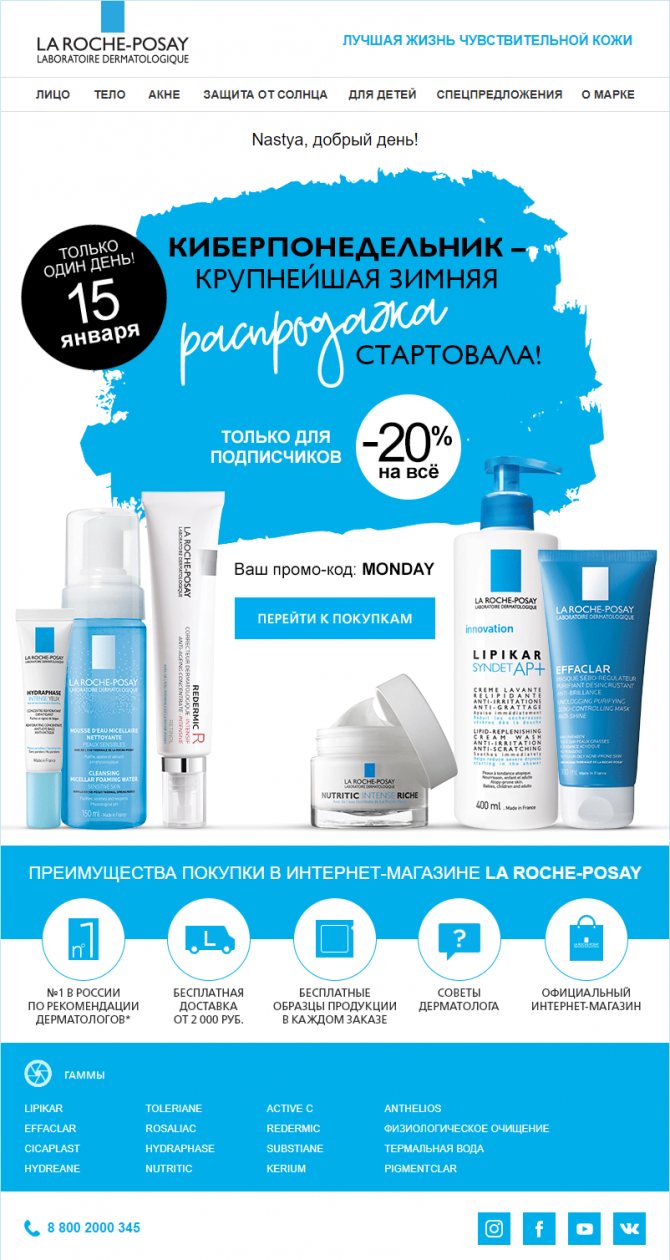
Green - we encourage you to take care of nature
This color symbolizes nature, and nature is harmony, vitality and a new beginning. Dark shades are associated with wealth and stability, while light shades are associated with kindness and compassion.
Focus on green if the company's corporate policy is related to environmental friendliness. Tentree is an eco-friendly clothing brand. When the company reminds subscribers about the importance of protecting the environment, the emails are filled with rich colors of fresh greenery.

Purple - adds mystery, but not too much
Associated with luxury and secrets. The color purple motivates a person to solve pending tasks and problems, and most importantly, it evokes a desire to create.
Online clothing stores use light shades of purple to emphasize romance, while cosmetics brands convey mystery with darker shades. Try to use this color in moderation without distracting from the main thing, as NYX does.

Black color - complement other colors
This color signifies sophistication, control and independence. Since black is the absence of any color, it correlates with secrecy, individuality and restraint.
Negative meanings of black include evil, sadness, depression and even death. So in your mailings, dilute it with other colors. Send intense black emails only to specific audiences or on special occasions. The Pull&Bear newsletter is dedicated to Black Friday and the chosen color corresponds to the occasion.

Interpretation of some definitions of the Szondi test
Entry text:
Abel's tendencies (Abel - bib
Abel tendencies (Abel is a biblical character innocently killed by his brother Cain) are an expression of goodwill, emphasized meekness, morality, moral purity, and selflessness.
Agitated activity - disordered activity against a background of elevated mood, hypomania.
Allodestruction is the experience of destruction of the picture of the surrounding world with a violation of primary trust in people.
Ambitiousness is the duality and inconsistency of motivation.
Anal-masochistic tendencies are a combination of anal-erotic traits with anancastic ones (passivity, dependence, increased sense of guilt).
The anal-erotic type is a personality type characterized by the deification of the object of love affection, which makes it difficult to realize sexual desire; competitive attitude towards the father, jealousy and tenderness towards the mother, transferred to the object of love affection; the desire to hoard, pedantry, stubbornness as character traits.
Autism is isolation, a focus on the world of one’s own ideas and fantasies, and isolation from others.
Autodestruction is the destruction of one’s own “I”, including through alcohol or drugs.
Affective discharge - 1) an apathetic state after an attack (paroxysm) or storm of anger, rage, hatred; 2) calm after a migraine, epileptic seizure, neurotic, allergic or psychosomatic disorder; 3) relaxation after making a difficult decision.
“Affective flood” - emotional exaltation, agitation, unjustified enthusiasm, an abundance of emotions associated with emphasized conscientiousness and a heightened sense of justice.
Affective preoccupation is emotional tension poorly controlled by reason, colored by subjectivity and bias.
Secondary masochism is an aggravation of sexual sensations from both physical and moral pain emanating from the object of affection.
Hypomania is an unmotivated elevated mood level.
Destructive need - the need for destructive aggressive discharge.
Disintegration of the “I” - disturbed intrapersonal harmony, weakened self-control, inadequate self-esteem.
The dominant ethical principle in the absence of a brake is the open manifestation of subtle emotional experiences associated with love and tenderness.
Dominance - predominance.
Dualunion is a painful attachment to mother or father with mutual aggression, leaving an imprint on the lifestyle.
The rigidity of the male major “I” is a vivid manifestation of masculinity, manliness.
Inversion is a deviation in normal sexual desire, which involves being directed towards people of the opposite sex.
Incestuous love is sexual relations with a close relative.
Cain tendencies (Cain is a biblical character who killed his brother) - an expression of rigidity, selfishness, cynicism, disregard for moral principles
Catatonic manifestations are a motor stupor or a storm, beyond the control of the “I” due to the disintegration of the personality.
Introjection is the inclusion of the entire surrounding world into one’s “I” with inflated self-esteem.
Inflationary paranoid is a wary and delusional attitude towards the environment as hostile.
The Don Juanism complex is the self-affirmation of an insecure person through an exorbitant expansion of contacts that are essentially superficial.
Latent - hidden.
A libidinal-stagnant personality is a person with unfulfilled libidinal needs.
Libidinal need is the intensity of the need for activity, which can manifest itself not only as the need for sex, but also as self-realization of the individual in a broad sense.
Masochistic tendencies - a tendency to self-torment (with an increased sense of guilt or the ability to experience special pleasure when pain is caused by another person, including a sexual partner at the moment of intimacy.
Manic manifestations are excessive ideational disinhibition, that is, verbosity, an influx of ideas, a sharply increased emotional background with weakened self-control and inadequately inflated self-esteem.
Melancholic reaction is a reduced mood background.
Mythomania is lying as a defensive reaction to life’s reality.
Soft, minor “I” - femininity, femininity.
Moral masochism is a pronounced tendency toward self-sacrifice, an increased sense of guilt, and the replacement of libidinal needs with professional, social or spiritual employment.
Multilateral communication is a multiplicity of contacts without the depth of relationships.
Narcissistic traits - self-centered narcissism, focus on one's "I".
Unfulfilled homosexuality with narcissistic manifestations is a latent (hidden) or well-controlled (suppressed) attraction to people of the same sex with narcissism and self-centered focus on one’s “I”.
Paranoid phenomena are delusional judgments based on impaired perception.
Paranoia - wariness, distrust, readiness to build a delusional concept in the sphere of interpersonal relationships.
The primary form of masochism is the desire to experience cruelty and pain from a sexual partner at the moment of intimacy.
Pseudology is pathological deceit.
The problem of an insoluble dual union is a painful attachment to one of the family members with a painful sadomasochistic relationship that cannot be changed or interrupted.
Discharge after an affective outburst is a feeling of relaxation after experiencing an emotional storm.
The regressive form of contact is a form of communication inherent in the period of early childhood. Infantilism.
The regressive form of interpersonal communication is immature, infantile, characteristic of a child in early childhood.
A weakly integrated “I” is an insufficiently strong and harmoniously organized “I”, which can be manifested by poor self-understanding, unstable self-esteem and reduced self-control.
Sadism is a cruel form of fulfillment of sexual needs, which also manifests itself as destructive tendencies in interpersonal communication.
Sadohumanism is a declared selflessness and humanity with harsh methods of putting pressure on others.
Sadomasochism is an alternating manifestation of sadistic (cruel) and masochistic (submissive) tendencies, a regressive form of sexuality; sadomasochism, in addition to sexual contacts, can manifest itself along with strong attachment in increased demands on the object of affection and a patient attitude towards his cruelty (“tormented tormentor”).
The weakness of moral censorship is self-exposure or self-demonstration in the absence or weakness of control of reason over emotions.
The desire for participation is self-isolation, focus on one’s inner world.
Sublimation of libidinal need is the translation of unfulfilled sexual need into one or another type of social activity.
Unifunctional dominant - the predominance of a single drive as dominant.
Phobic experiences are fears that cannot be controlled or criticized.
Schizoid manifestations - isolation, subjectivism, wariness, individualism, originality of statements and actions, emotional coldness, egocentrism.
The Oedipus complex is the deification of the object of love, which makes it difficult to realize sexual desire. Competitive attitude towards father, jealousy and tenderness towards mother, transferred to the object of love affection.
Exhibitionism is self-exposure or self-demonstration.
Epi-disorders are painful manifestations of the type of epilepsy (paroxysmal, paroxysmal nature of the disorder with convulsive phenomena against the background of altered consciousness or outbursts of unmotivated rage against the background of viscous concrete thinking, painfully manifested pedantry and sweetness).
Eros-hypertonic reaction is an excessive, intense need for tenderness (sexual or interpersonal) aimed at a specific person.
Eros need is the need for tender (sexual and human) contacts.
Erotomania is sexual disinhibition.
Eros factor is a factor of tenderness directed at a specific person.
S-risk is the danger of committing suicide, that is, committing suicide.
White color - balancing the elements of the letter
Traditionally it is associated with purity and innocence. White is a balanced combination of all the colors of the palette, so it can both charge you with vigor and optimism, and calm you down and drive away fears. But too much white can make people feel lonely and empty.
In newsletters, this color is most often used as a background, since it highlights the rest of the letter elements and matches all colors. Look at the newsletter from Cuyana - the white background gives a lightness, making the design look neat and restrained.
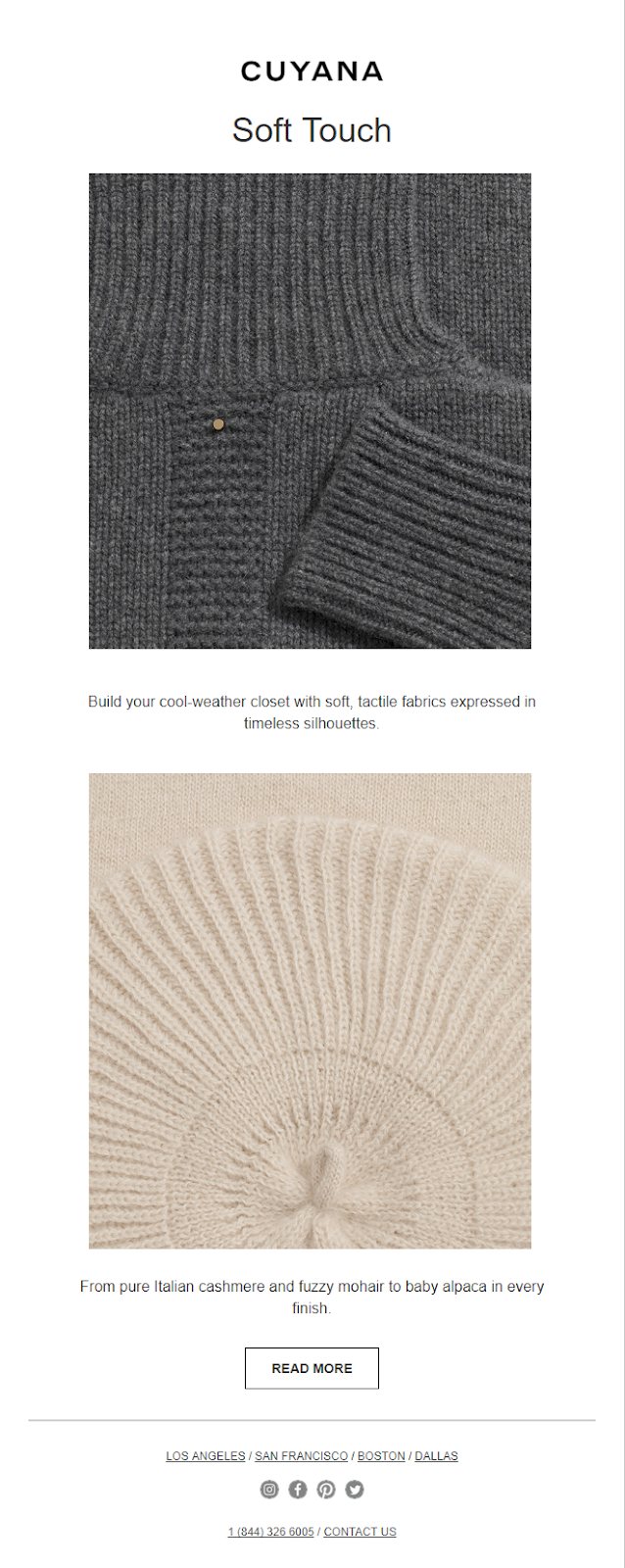
Factors influencing a person's mood
It is within the power of a person to raise his morale, try to cheer up and tune in to a positive mood. But the reasons for our mood are often unconscious. How can factors influence it?
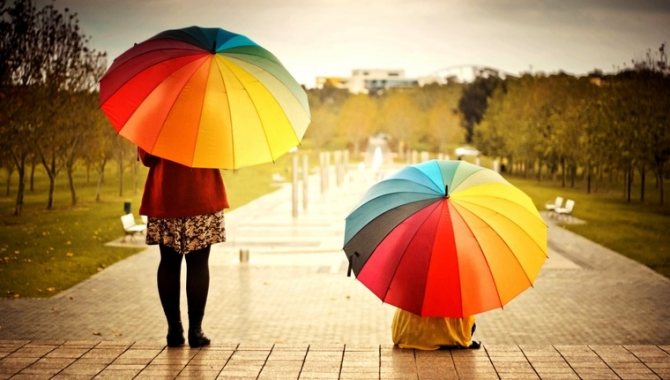
Physical condition of the body
"In a healthy body healthy mind!" - This is true. Our mood is closely related to the state of various systems: endocrine, vegetative-vascular, nervous, hormonal.
Mood swings often occur due to hormonal imbalances, and heart problems lead to emotions of fear and melancholy. Many people know what a disgusting mood after drinking a large amount of alcohol, the poisoned body takes revenge on its owner.
It happens that neurons limit the production of proteins serotonin and dopamine, which are hormones of joy and happiness, then despondency and melancholy set in. The state of health is not among the primary factors of melancholy or mood, only in the presence of severe mental or physical disorders.
Objective circumstances
The leading reasons influencing the emotional background are external factors. Any event that does not seem worthy of attention at first glance can contribute to a change in mood. Moreover, it is difficult to immediately say in which direction our emotions will move.
Imagine early spring, you went outside, the sun is shining brightly after a long winter. This fact can fill you with joy for the whole day; we, like any living creature, have been strengthened by the energy of the luminary. But, literally, after 100 meters, a passing car splashed your expensive suit, and now the state of euphoria has already disappeared somewhere, giving way to annoyance and irritation.
Psychologists believe that further emotional background will depend on two factors:
- the significance of each circumstance personally for the person;
- an individual's predisposition to perceive positive or negative emotions.
For one of us, rain is a spoiled mood for the whole day, for the second it is an opportunity to run through puddles, like in childhood, and read a book at home.
There are external reasons that will definitely plunge a person into a serious state - death or separation from loved ones, loss of livelihood, illness of a child, news of losses, etc. No sane person would have fun in such situations. Nevertheless, there is a way out of any trouble (except death), a mature person will look for it and find it. Prolonged suffering will lead to loss of meaning in life and psychological pathologies.
Mental characteristics of personality
All people are divided conditionally into 4 psychotypes, on which their characteristic emotional background depends:
- Phlegmatic people do not get excited by momentary emotions
. Their mood is maintained for a long time and is not subject to frequent changes. The experiences of phlegmatic people have a calm course, they are smoothed out. Therefore, the mood of such people is mainly neutral or working. - Cholerics flare up like matches
. Emotions and feelings are always sharp, bright, if there is delight, then to a squeal, if anger, then to assault. Their life is an emotional swing. But experiences do not last long; they quickly cool down. Accordingly, the mood with such a temperament changes quickly (five minutes of laughter, five minutes of tears). - Melancholic people are always in a state of unaccountable sadness
. Remember Pierrot from the fairy tale about the wooden Pinocchio. Such people have a low emotional background and are unable to experience bright positive emotions. Any external obstacle can ruin an already bad mood. - Sanguine people are able to experience vivid feelings, but their emotions are closer to calm
. Such people do not dwell on the negative for a long time, have high self-esteem, and are able to control their mood. They spend most of their time in a cheerful mood, sometimes in a neutral state.
When we learn to recognize the factors that influence our mood, we can change it.
